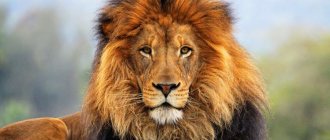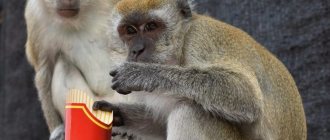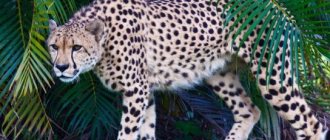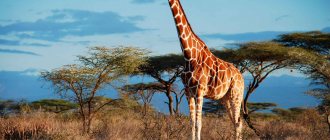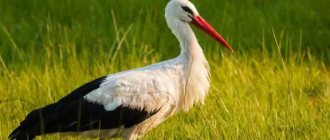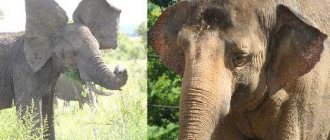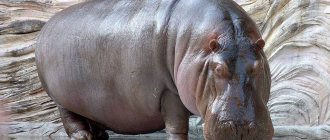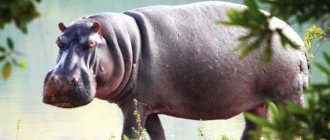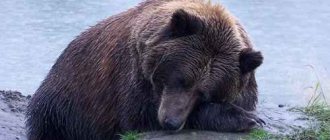Evolution of monkeys
Apes are the closest relatives of humans.
They have 32 teeth and no tail. Their limbs resemble human arms and legs, but their feet are not adapted to walking on the ground for long periods of time. Despite this, these animals can still move on their hind limbs. Another “human” trait of great apes is their flat chest. It is possible that humans and African apes had common ancestors. Great apes, like primitive man, are able to use simple tools, such as stones and sticks, to get food.
7) Sex
Bonobos are famous for their sexual appetites. Common chimpanzees can become angry and use force in some situations when, like bonobos, they prefer to resolve everything peacefully through sexual pleasure. They also greet each other and express affection through sexual stimulation. Common chimpanzees do not have sex for fun, and mating lasts no more than 10-15 seconds, while they can eat or do something else.
Friendship or emotional attachment does not matter in the choice of mating partners, and a female in estrus usually mates with several partners who patiently wait their turn.
Humans are known to experience sexual pleasure, as do bonobos, and procreative sex can last for quite a long time with great effort. Moreover, people often have long-term relationships with partners. Unlike humans, chimpanzees have no concept of sexual jealousy or competition, since they are not prone to long-term relationships with the same sexual partner.
Great and little monkeys
For certain reasons, some scientists tend not to include gibbons in the group of great apes. Today, the gibbon family is included in the superfamily of apes. Gibbons live exclusively in Asia from the Indian state of Assam to Indochina. In some species, males and females have different colors. Male Hoolock Gibbons, Hoolock Gibbons, and Kloss's Gibbons have black coats, while their females and cubs have light brown or gray coats. Large apes in Asia are represented only by the orangutan, whose range is limited to the forests of Kalimantan and Sumatra. Chimpanzees, pygmy chimpanzees and gorillas are found in West and Central Africa. All large apes sleep in nests that they build in trees, and only gorillas sleep on the ground.
Gibbons have calluses on their buttocks, so they can sleep while sitting on hard tree branches. Apes, who do not have such calluses, sleep lying down in a nest, which is lined with leaves. Apes live quite a long time: gibbons - about 25 years, large species - up to 50 years.
Classification
Apes are classified in the following taxonomic hierarchy:
- Domain: Eukaryotes;
- Kingdom: Animals;
- Phylum: Chordata;
- Class: Mammals;
- Order: Primates;
- Superfamily: Hominoids.
The term ape refers to a group of primates that includes the families: hominids (chimpanzees, gorillas, orangutans) and gibbons. The scientific name Hominoidea refers to apes (chimpanzees, gorillas, orangutans, gibbons) as well as humans (i.e., ignoring the fact that humans prefer not to call themselves apes).
The gibbon family is the most diverse, with 16 species. Another family, the hominids, is less diverse and includes: chimpanzees (2 species), gorillas (2 species), orangutans (3 species) and humans (1 species).
Methods of movement of monkeys
The smallest representatives of the group of apes are gibbons, whose mass reaches 8 kg. With extraordinary ease, they deftly jump along tree branches. When moving, monkeys cling to branches only with their hands. Swinging like a pendulum, they can jump up to ten meters. When jumping, monkeys reach speeds of about 16 kilometers per hour. Hanging on a branch with one arm and swinging, gibbons move far forward, using both paws when landing. They have very mobile shoulder joints that rotate 360°. Most apes are good tree climbers, choosing thick branches that can support their body weight. Orangutans distribute their weight on all four limbs; they do not jump. Pygmy chimpanzees, or bonobos, behave like real acrobats in the treetops. All apes have long arms and rather short hind limbs. Most of them move on the ground on all fours. Gorillas and chimpanzees, as well as bonobos, walk using the fingers of their forelimbs, while orangutans rely on their fists.
Eastern hoolock
Height – 60-80 cm, weight – 6-9 kg.
Previously, this cute monkey with eternally surprised white eyebrows belonged to gibbons, but in 2005, after molecular research, it was separated into two species: western and eastern hoolock . And the eastern one is one of the largest primates.
Males are larger and black in color, females are black-brown and instead of white arches they have light rings around their eyes, like a mask. The hulock lives in southern China, Myanmar and the far east of India.
Lives mainly in tropical, sometimes in deciduous forests. Prefers to occupy the upper tiers, does not like water and feeds on fruits. Hoolok forms a very strong pair with his female, and the cubs are born white, and only over time their fur turns black.
Sounds made by monkeys
The largest gibbon, the siamang, has a throat pouch that it can inflate. The leathery sac plays the role of a resonator, which amplifies the sound. Usually the monkey makes sounds that resemble a dull bark. Members of the same herd within their territory also communicate using sound signals, and the females are the most active - their first long barking sounds gradually shorten until they completely subside, and then the monkeys begin the “conversation” again. The males respond with low calls that turn into roars. Obviously, the cry serves siamangs not only to mark the boundaries of the territory, but is an element of a complex communication system. Adult male orangutans also have throat sacs called resonators. Their loud voices can be heard at a distance of one kilometer. The male gorilla, sensing danger, rises to his hind limbs, beats his chest with his hands and shouts: “tok-tok-tok.” This behavior is called demonstrating. Chimpanzees and pygmy chimpanzees (bonobos) communicate with each other using cries, grunts, squeals and snorts. The chimpanzee's danger call is a very high-pitched, loud sound that can be heard over a long distance.
Sumatran orangutan
Height – 100-150 cm, weight – 50-100 kg.
The Sumatran orangunang is the third species of one of the largest monkeys on the planet. Representatives of this species are thinner and taller than their relatives from the island of Borneo. However, they also have very strong limbs and well-developed muscles. They have a mostly short red-brown coat that is long at the shoulders. The legs are short, but the arms span is large, up to 3 m.
Like all members of the genus, orangutans from Sumatran spend most of their lives in trees. They feed on fruits, honey, bird eggs, and sometimes chicks and insects. They drink from the hollows of trees, from wide leaves, and even lick their own fur, because they are terribly afraid of water, and if they find themselves in a pond, they will immediately drown.
Ape food
Gorillas eat leaves, fruits, bark, mushrooms, buds and shoots. One subspecies, the lowland gorilla, found in West Africa, eats insects and their larvae. Gibbons feed mainly on ripe fruits. Orangutans eat fruits, leaves, insects, and bird eggs. Chimpanzees are omnivorous apes. The basis of their diet is fruits, leaves and seeds, but chimpanzees readily eat ants, termites, larvae and bird eggs. Sometimes they destroy bee nests by eating larvae and honey. Chimpanzees hunt baby antelopes, baboons and wild pigs. They crack nuts with stones.
Nutrition
The diet of hominoids includes leaves, seeds, nuts, fruits and a limited number of animals. Most species are omnivores, but fruits are the preferred food. Chimpanzees and orangutans primarily eat fruit. When gorillas lack fruit at certain times of the year or in certain regions, they feed on shoots and leaves, often bamboo. Gorillas are well adapted to chew and digest such a low-nutrient food, but these primates still prefer fruit when it is available. Hominoid teeth are similar to those of Old World monkeys, although they are especially large in gorillas.
Reproduction
Apes enter puberty late. Gibbons begin to mate at the age of 6-7 years. A female chimpanzee gives birth to her first baby between the ages of 6 and 9 years. Males of large apes reach sexual maturity somewhat later - at 7-8 years. Female chimpanzees mate with different males from the herd. In gorillas, only the leader of the herd has the right to mate with all females. Orangutans live alone, so the female mates with the male she meets during the breeding season. Pregnancy lasts approximately 7 months for gibbons and 9 months for gorillas. The female gives birth to one cub; twins are rarely born. Gibbons feed their cubs milk for several months, larger monkeys longer.
A baby chimpanzee often feeds on its mother's milk for 4 years, and then lives for a long time with its mother, who carries it long distances on her back. Female gibbons usually give birth to cubs every 2 years, gorillas every 2-3 years, and chimpanzees every 5-6 years. A baby in a herd of gorillas feels safe because all members of the herd protect him from enemies.
Behavior
Like most primates, hominoids form social groups, the structure of which varies among species. Gibbons form monogamous pairs. Orangutans are an exception to the social norm of primates; they lead a solitary life.
Chimpanzees form groups that can number from 40 to 100 individuals. Large groups of chimpanzees break up into smaller groups when fruit becomes less available. If small groups of dominant male chimpanzees go off to find food, the females will often copulate with other males in their group.
Gorillas live in groups of 5 to 10 or more individuals, but they remain together regardless of the availability of fruit. When fruits are difficult to find, they resort to eating leaves and shoots. Because gorillas stay together, the male is able to monopolize the females in his group. This fact is associated with greater sexual dimorphism in gorillas than chimpanzees. In both chimpanzees and gorillas, groups include at least one dominant male, with females leaving the group in adulthood.
Speech
Since ancient times, people have sought to establish contact with animals. Many scientists have studied the issues of teaching speech to great apes. However, the work did not produce the expected results. Primates can only produce isolated sounds that bear little resemblance to words, and their vocabulary in general is very limited, especially compared to talking parrots. The fact is that narrow-nosed primates lack certain sound-producing elements in the oral cavity in organs corresponding to humans. This is what explains the inability of individuals to develop skills in pronouncing modulated sounds. Monkeys express their emotions in different ways. So, for example, a call to pay attention to them is with the sound “uh”, passionate desire is manifested by panting, threat or fear is manifested by a piercing, sharp cry. One individual recognizes the mood of another, looks at the expression of emotions, adopting certain manifestations. To convey any information, facial expressions, gestures, and posture are the main mechanisms. With this in mind, the researchers tried to start talking to the monkeys using sign language, which is used by deaf and mute people. Young monkeys learn signs quite quickly. After a fairly short period, people were able to talk with animals.
Perception of beauty
The researchers noted, not without pleasure, that monkeys love to draw. In this case, primates will act quite carefully. If you give a monkey paper, a brush and paints, then in the process of depicting something, he will try not to go beyond the edge of the sheet. In addition, animals are quite skillful in dividing the plane of paper into several parts. Many scientists consider the paintings of primates to be strikingly dynamic, rhythmic, full of harmony in both color and form. More than once it was possible to show the work of animals at art exhibitions. Researchers of primate behavior note that monkeys have an aesthetic sense, although it manifests itself in a rudimentary form. For example, while observing animals living in the wild, they saw how individuals sat at sunset on the edge of the forest and watched the sun set in fascination.
Appearance of a monkey
There are tiny individuals whose body length is only 15 cm. And gorillas can grow up to two meters or more. Some representatives weigh no more than 150 grams, and there are monkeys weighing about 300 kg. Highly organized mammals have a face and have rich facial muscles.
Most primates prefer to live in trees, so they are characterized by a long back. They also have a narrow chest. Gibbons are distinguished by a massive hip part of the body.
The body of all primates is covered with hair of varying lengths and thickness. The color depends on the type of animal. As primates age, they begin to turn grey, and some become bald.

